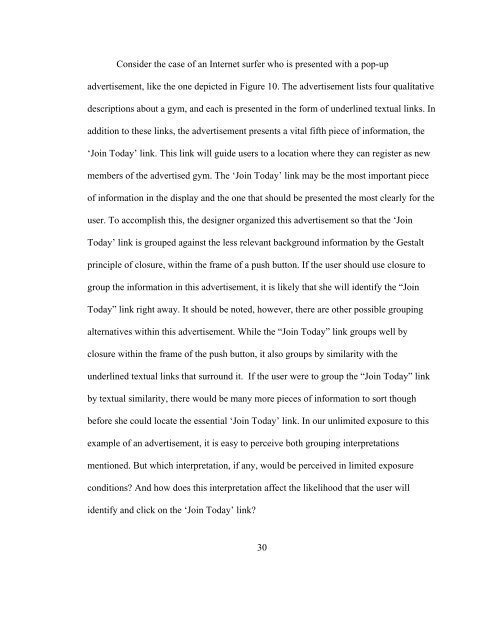The Use of Iambic Pentameter in the
The Use of Iambic Pentameter in the
The Use of Iambic Pentameter in the
You also want an ePaper? Increase the reach of your titles
YUMPU automatically turns print PDFs into web optimized ePapers that Google loves.
Consider <strong>the</strong> case <strong>of</strong> an Internet surfer who is presented with a pop-up<br />
advertisement, like <strong>the</strong> one depicted <strong>in</strong> Figure 10. <strong>The</strong> advertisement lists four qualitative<br />
descriptions about a gym, and each is presented <strong>in</strong> <strong>the</strong> form <strong>of</strong> underl<strong>in</strong>ed textual l<strong>in</strong>ks. In<br />
addition to <strong>the</strong>se l<strong>in</strong>ks, <strong>the</strong> advertisement presents a vital fifth piece <strong>of</strong> <strong>in</strong>formation, <strong>the</strong><br />
‘Jo<strong>in</strong> Today’ l<strong>in</strong>k. This l<strong>in</strong>k will guide users to a location where <strong>the</strong>y can register as new<br />
members <strong>of</strong> <strong>the</strong> advertised gym. <strong>The</strong> ‘Jo<strong>in</strong> Today’ l<strong>in</strong>k may be <strong>the</strong> most important piece<br />
<strong>of</strong> <strong>in</strong>formation <strong>in</strong> <strong>the</strong> display and <strong>the</strong> one that should be presented <strong>the</strong> most clearly for <strong>the</strong><br />
user. To accomplish this, <strong>the</strong> designer organized this advertisement so that <strong>the</strong> ‘Jo<strong>in</strong><br />
Today’ l<strong>in</strong>k is grouped aga<strong>in</strong>st <strong>the</strong> less relevant background <strong>in</strong>formation by <strong>the</strong> Gestalt<br />
pr<strong>in</strong>ciple <strong>of</strong> closure, with<strong>in</strong> <strong>the</strong> frame <strong>of</strong> a push button. If <strong>the</strong> user should use closure to<br />
group <strong>the</strong> <strong>in</strong>formation <strong>in</strong> this advertisement, it is likely that she will identify <strong>the</strong> “Jo<strong>in</strong><br />
Today” l<strong>in</strong>k right away. It should be noted, however, <strong>the</strong>re are o<strong>the</strong>r possible group<strong>in</strong>g<br />
alternatives with<strong>in</strong> this advertisement. While <strong>the</strong> “Jo<strong>in</strong> Today” l<strong>in</strong>k groups well by<br />
closure with<strong>in</strong> <strong>the</strong> frame <strong>of</strong> <strong>the</strong> push button, it also groups by similarity with <strong>the</strong><br />
underl<strong>in</strong>ed textual l<strong>in</strong>ks that surround it. If <strong>the</strong> user were to group <strong>the</strong> “Jo<strong>in</strong> Today” l<strong>in</strong>k<br />
by textual similarity, <strong>the</strong>re would be many more pieces <strong>of</strong> <strong>in</strong>formation to sort though<br />
before she could locate <strong>the</strong> essential ‘Jo<strong>in</strong> Today’ l<strong>in</strong>k. In our unlimited exposure to this<br />
example <strong>of</strong> an advertisement, it is easy to perceive both group<strong>in</strong>g <strong>in</strong>terpretations<br />
mentioned. But which <strong>in</strong>terpretation, if any, would be perceived <strong>in</strong> limited exposure<br />
conditions? And how does this <strong>in</strong>terpretation affect <strong>the</strong> likelihood that <strong>the</strong> user will<br />
identify and click on <strong>the</strong> ‘Jo<strong>in</strong> Today’ l<strong>in</strong>k?<br />
30

















